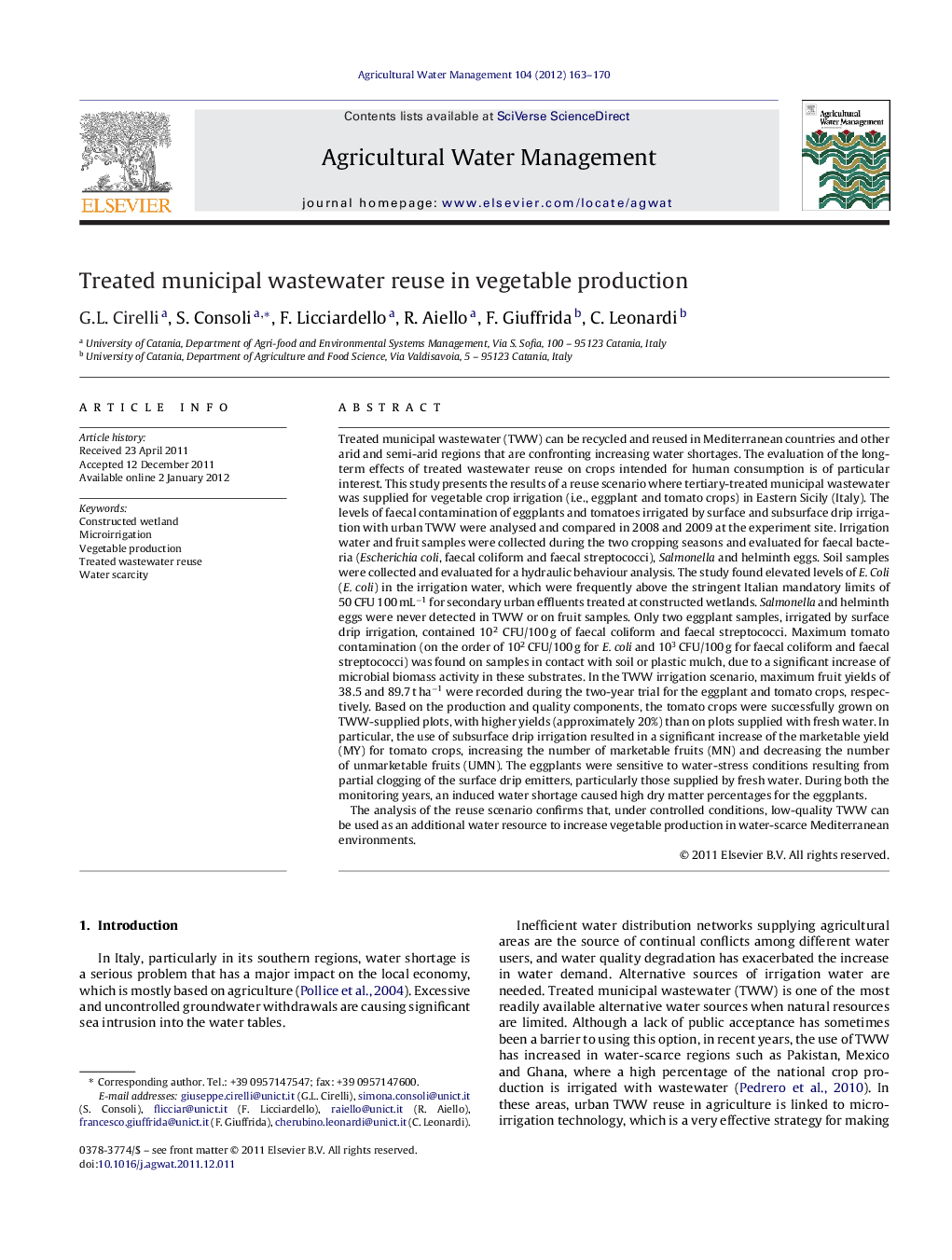| کد مقاله | کد نشریه | سال انتشار | مقاله انگلیسی | نسخه تمام متن |
|---|---|---|---|---|
| 4479182 | 1622975 | 2012 | 8 صفحه PDF | دانلود رایگان |

Treated municipal wastewater (TWW) can be recycled and reused in Mediterranean countries and other arid and semi-arid regions that are confronting increasing water shortages. The evaluation of the long-term effects of treated wastewater reuse on crops intended for human consumption is of particular interest. This study presents the results of a reuse scenario where tertiary-treated municipal wastewater was supplied for vegetable crop irrigation (i.e., eggplant and tomato crops) in Eastern Sicily (Italy). The levels of faecal contamination of eggplants and tomatoes irrigated by surface and subsurface drip irrigation with urban TWW were analysed and compared in 2008 and 2009 at the experiment site. Irrigation water and fruit samples were collected during the two cropping seasons and evaluated for faecal bacteria (Escherichia coli, faecal coliform and faecal streptococci), Salmonella and helminth eggs. Soil samples were collected and evaluated for a hydraulic behaviour analysis. The study found elevated levels of E. Coli (E. coli) in the irrigation water, which were frequently above the stringent Italian mandatory limits of 50 CFU 100 mL−1 for secondary urban effluents treated at constructed wetlands. Salmonella and helminth eggs were never detected in TWW or on fruit samples. Only two eggplant samples, irrigated by surface drip irrigation, contained 102 CFU/100 g of faecal coliform and faecal streptococci. Maximum tomato contamination (on the order of 102 CFU/100 g for E. coli and 103 CFU/100 g for faecal coliform and faecal streptococci) was found on samples in contact with soil or plastic mulch, due to a significant increase of microbial biomass activity in these substrates. In the TWW irrigation scenario, maximum fruit yields of 38.5 and 89.7 t ha−1 were recorded during the two-year trial for the eggplant and tomato crops, respectively. Based on the production and quality components, the tomato crops were successfully grown on TWW-supplied plots, with higher yields (approximately 20%) than on plots supplied with fresh water. In particular, the use of subsurface drip irrigation resulted in a significant increase of the marketable yield (MY) for tomato crops, increasing the number of marketable fruits (MN) and decreasing the number of unmarketable fruits (UMN). The eggplants were sensitive to water-stress conditions resulting from partial clogging of the surface drip emitters, particularly those supplied by fresh water. During both the monitoring years, an induced water shortage caused high dry matter percentages for the eggplants.The analysis of the reuse scenario confirms that, under controlled conditions, low-quality TWW can be used as an additional water resource to increase vegetable production in water-scarce Mediterranean environments.
► We analysed a treated wastewater (TWW) reuse scenario in a semi-arid climate region of southern Italy.
► The effects on the bacteriological quality and yield components of vegetable crops irrigated with TWW were evaluated.
► The microbiological quality of the products (i.e., eggplant and tomato) was generally maintained, although the Escherichia coli content in TWW was often over the limits set by the Italian government.
► Potential contaminations scenarios were assessed based on Italian and WHO guidelines.
Journal: Agricultural Water Management - Volume 104, February 2012, Pages 163–170